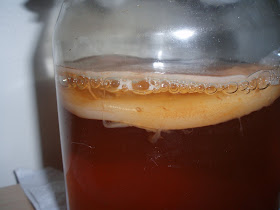 So I will start off with some good news that I feel that I really should have mentioned long ago- Whole Foods Brighton is now carrying Katalyst Kombucha! Typically I only find GT's brand at Whole Foods stores, so I am very excited about this new (and local) addition!
So I will start off with some good news that I feel that I really should have mentioned long ago- Whole Foods Brighton is now carrying Katalyst Kombucha! Typically I only find GT's brand at Whole Foods stores, so I am very excited about this new (and local) addition!However, this is not the only recent addition to Whole Foods stores. I had heard the rumors, but was nevertheless still surprised when I found Honest Tea's Honest Kombucha at Whole Foods at the Charles River Plaza.
Yes, Honest Tea has joined the kombucha craze, and is selling three varieties of kombucha at Whole Foods stores: peach mango, berry hibiscus, and lemon ginger.


Don't worry, these bottles are glass, and not plastic.
Even though I brew my own kombucha, of course I had to try a bottle, which cost $3.49 each. I went for the lemon ginger, because I can never miss an opportunity to add more ginger to my life. My opinion: it was too sweet, lacked the vinegar-like taste of traditional kombucha, and was not very fizzy. An 8 oz. serving of Honest Kombucha has 7 g of sugar, compared to GT's 2-4 g sugar or Katalyst's 6 g of sugar per 8 oz. serving. The absent vinegar taste may be missed by some homebrewers, but this could also be a quality to convert that tentative friend. Fizziness is a matter of personal preference, and may be related to the fact that the bottle was not filled up to the top?.
While it's great that Honest Tea's introduction of Honest Kombucha will increase awareness about this drink, I still love the freshness of Katalyst Kombucha and how the taste is reminiscent of a homebrew. And as a local foodie, I am all for my local, independently owned companies. Ideally, though, homebrewing is the way to go for me. It's easy, inexpensive, and fun, gives you a much fresher and sometimes more healthful product, and allows you to tweak your kombucha to however you like it!
Honest Tea is 40% owned by Coca-Cola, and Coca-Cola is expected to buy the other 60% by the end of 2010.
However, Coca-Cola isn't the only large company that has joined the kombucha market.
- Kombucha Wonder Drink is owned by Tazo (launched in 2003)
- Carpe Diem Kombucha was launched in 2007 by Red Bull
- Celestial Seasonings acquired infinitea kombucha this past year
And speaking of kombucha on tap, thanks to the Boston Localvores for informing us that kombucha is also sold on tap at the Concord Food Coop in New Hampshire. Concord Food Coop, here I come!
Enjoy the holidays everyone!
Sources of information (and recommended articles):
Forbes: Kombucha: Can This 'Cure-All' Help Boost Beverage Sales?
World Tea News: Kombucha Not Just for Hippies, but Is It for You?
















































